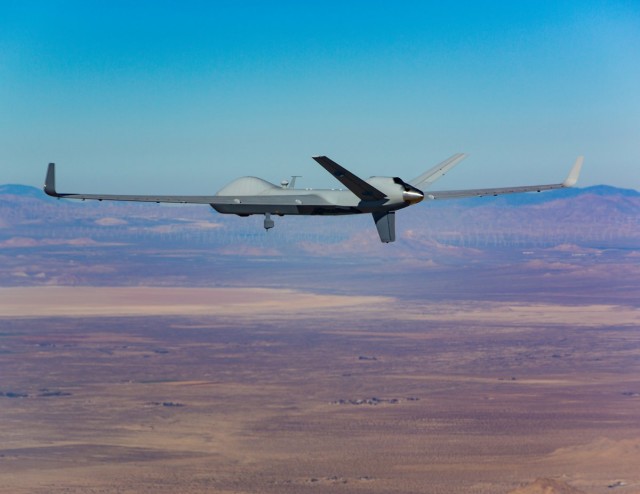 Hughes Network Systems will provide satellite communications for the United Kingdom’s fleet of Predator B remotely piloted aircraft, the company announced March 6.
Hughes Network Systems will provide satellite communications for the United Kingdom’s fleet of Predator B remotely piloted aircraft, the company announced March 6.
General Atomics Aeronautical Systems awarded Hughes Defense Intelligence Systems Division the communications systems contract. The companies have not disclosed the sum, only saying that it is a multi-million dollar deal.
The new aircraft is designed to be compliant with NATO and UK airworthiness requirements, supporting easy integration into segregated and non-segregated civil airspace operations around the world.
“We are proud to have been selected for the SkyGuardian platform and its enhanced SATCOM capability,” said Rick Lober, vice president and general manager of Hughes DISD. “With the development and supply of our customized HM series modem, aircraft operators and mission personnel will experience the benefits of protected SATCOM which includes the flexibility to employ the most appropriate frequencies for Beyond-Line-of-Sight (BLoS) communication.”
Hughes will provide modems for the onboard communications systems, designed to work with any number of communications satellites. The initial capability will be focused on X-band provided by the U.K.’s Skynet 5 constellation.
But the systems are designed to work with many other frequencies, said Lober.
“It’s frequency band agnostic,” he told SpaceNews. “The satcom link is designed to work on commercial satellites or military satellites…The modem itself will operate in any band. If you have a Ku-band antenna or a Ka-band antenna, the modem will operate with them.”
Hughes will install a modified version of their HM 200 military airborne package modem designed to work with rotary-wing aircraft. The work is expected to be completed by 2018.
The company has been able to reduce the size, weight, and power over previous systems, Lober said, and the open architecture means future improvements can be easily swapped in.
“If an improved modem comes along they can use that; if improved antennas come along they can use those,” he said. “They’re not locked into a single vendor for the entire subsystem.”
Since most unmanned aerial vehicles are used for military intelligence gathering, the communications systems are designed for downloading massive amounts of data from the platform. It’s almost the exact opposite, Lober said, of Hughes other efforts (like their Jupiter System) to allow in-flight users to communicate, connect to the internet, and download lots of data to the plane.
This series of Predator B UAVs is being dubbed the “SkyGuardian,” part of the U.K. Ministry of Defence’s Protector program designed to supply the next generation of unmanned aerial systems. The Predator Bs are designed to more easily integrate into civilian airspace than existing Predators, and meet U.K. and NATO civilian airworthiness requirements.
Making sure that the Predator meets civilian airspace requirements — and ensuring the communications system can work with commercial satellites — opens up the possibilities on what the craft can be used for, Lober said.
“There are other than military applications. There’s firefighting, there’s search and rescue, there’s agriculture,” he said. “Once you can fly a UAV in civilian airspace, you have a lot of other applications besides what predators have traditionally been used for.”
Source: Press Release; Space News
